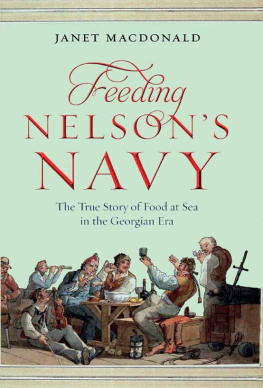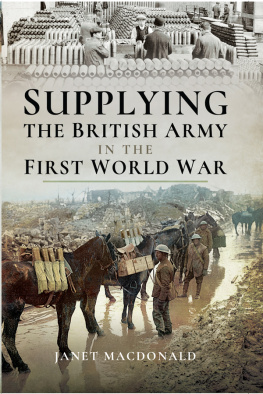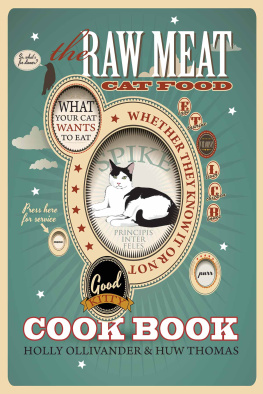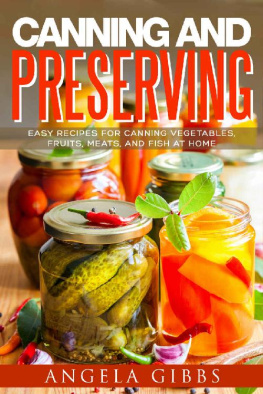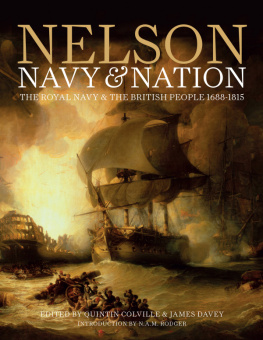JANET MACDONALD
has written over thirty books, including a number on cookery. Her parallel interests in food and naval history led her to undertake a Masters degree, and the resulting research into the victualling of the Nelsonic navy formed the starting point for this book. She was recently a featured historian on BBC Radio 4s Food at Sea programme.
FEEDING
NELSONS
NAVY
________
The True Story of Food at Sea
in the Georgian Era
JANET MACDONALD
First published in Great Britain in 2004 by
Chatham Publishing, Lionel Leventhal Limited
This paperback edition published in 2014 by Frontline Books
an imprint of Pen & Sword Books Ltd,
47 Church Street, Barnsley, S. Yorkshire, S70 2AS
www.frontline-books.com
Copyright Janet Macdonald 2004, 2006 & 2014
The right of Janet Macdonald to be identified as the author of this work has been asserted
by him in accordance with the Copyright, Designs and Patents Act 1988.
ISBN: 978-1-84832-747-4
All rights reserved. No part of this publication may be reproduced, stored in or introduced
into a retrieval system, or transmitted, in any form, or by any means (electronic, mechanical,
photocopying, recording or otherwise) without the prior written permission of the publisher.
Any person who does any unauthorized act in relation to this publication may be liable
to criminal prosecution and civil claims for damages.
CIP data records for this title are available from the British Library
For more information on our books, please visit
www.frontline-books.com, email info@frontline-books.com
or write to us at the above address.
Printed and bound by CPI Group (UK) Ltd, Croydon, CR0 4YY
CONTENTS
________
This book represents the first stage of what I hope will be a very long journey a journey which started with a food writer reading of some marvellous meals in a fictional series about a Napoleonic War naval captain and his friend, moved on to a general interest in the true history of what has come to be called Nelsons Navy and from there to the world of academia, archives, and serious historical research. Much of the fine detail for the book came from the research for my MA dissertation Victualling the British Mediterranean Fleet, July 1803 June 1804 (hence the predominance of references to that fleet, but other logs and documents strongly suggest that these reflect the general situation).
Along my journey I have received help and encouragement from many people, to all of whom I will be eternally grateful:
At the Greenwich Maritime Institute, my tutor Professor Roger Knight, the director Professor Sarah Palmer, Doctor Roger Morriss, who taught me how to use the various archives, and my fellow students who shared information with me, but especially Charles Consolvo and David Elvin.
At the archives, Jennie Wraight and Iain MacKenzie of the Admiralty Library; Jane Wickenden at the Institute of Naval Medicine; Andrew Helm at the Nelson Museum, Monmouth; Matthew Sheldon, Head of Research Collections and Richard Noyce, Curator of Artifacts at the Royal Naval Museum Portsmouth; Lt-Cdr. Nowoskielski, C.O. of HMS Victory; the staff at the British Library, the Caird Library at the National Maritime Museum at Greenwich, the Public Record Office, and the library of the Wellcome Trust.
Elsewhere, Professor Richard Harding of the University of Westminster for suggestions on logistics literature, John Harland for advice on stowage, Roel Mulder for information on Dutch naval food, Brian Vale for information on South America, Spain and Portugal, Andrew McCoig who checked my calorie and vitamin calculations and Clive Gardner who helped with Richard Ford.
Dave Balderstone, Compuserve History forum; Bryn Hughes, General Manager of HMS Trincomalee; Tyrone Martin of USS Constitution; Mark Nesbitt, Royal Botanic Gardens, Kew; Michael & Jane Phillips; Mr E J Revell; Bill Sargeant; Lord de Saumarez; Roderick Stewart of the Unicorn Preservation Society; Tim Voelcker; and all my e-friends at the Searoom forum who have shared information and ideas with me on this and many other topics.
And last but by no means least, my husband Ken Maxwell-Jones: assistant researcher, editor, proofreader, coffee maker and recipe sampler.
_____
T HE FIRST THREE THINGS you encounter when you start to read about the Georgian navy are all horror stories: the work of the press gangs, flogging, and the appalling food. I have my doubts as to whether the first two are as bad as they are painted, and I find it impossible to believe in the third. A navy fed on rotten meat and weevilly biscuits? My experience of the British working man is that the men would not have tolerated this, nor, on such a diet, would they have been capable of the very hard physical work involved in sailing and fighting a ship, let alone doing it with the enthusiasm and success which they did.
So my basic disbelief set me off on the trail of research into exactly what Nelsons navy did eat, how they ate it, where it came from and how it got to them. In the process I discovered the fascinating edifices of the Victualling Board and its sister organisations the Navy Board, the Sick and Hurt Board and the Transport Board, and their numerous employees in London and at naval establishments all over the world. The other side of the story, which is equally fascinating, is how the food was cooked and eaten, and the fact that sharing meals is not only a major social occasion but one which is important for maintaining the cohesion of any group of people.
Mealtimes also served a simpler purpose; that of refuelling the fleshy machines that kept the navy sailing. There is a simple progression: continuous hard work (and both sailing the ship and handling the guns are very hard work indeed) requires fit and healthy men; men will only stay fit and healthy if they are well fed. It is the naval version of Napoleons army marching on its stomach.
It is comparatively easy to feed a navy in peacetime, when numbers are low; it is also comparatively easy to feed a navy when it is operating in home waters and can return to port to replenish its stocks of food and drink. But when you are engaged in a major war, with over 1000 ships and 140,000 men (as was the case at the high point of the Napoleonic Wars in 1810) and when over half that force is operating in foreign waters, the logistics of keeping all those men fed would have been insurmountable without an efficient organisation to arrange things. Add to this the facts that for most of the period we are discussing, the only methods of preserving food were to dry it, salt it or pickle it, and the only practical bulk packaging materials were wooden casks and cloth bags, and you begin to see why the Admiralty elected to feed the navy on foodstuffs that owed more to durability than to what we would now think of as a balanced diet: salt meat, dried pease, oatmeal, hard tack and a little butter and cheese, with beer, wine or watered spirits to wash it down.
Once you know what they ate, questions come to you: was there no fresh meat, no vegetables or fruit? What about fish, or poultry? How was the food cooked and who cooked it? Where did it come from and how did it get from there onto the ships? Did the officers eat at the same time as the men? How many men ate at a time, and what about the men on urgent watch duties such as lookout or steering? Is it true about weevils and rats? Fortunately history has left us plenty of information about most, if not all, of these things, in the form of official correspondence between the Admiralty and the subsidiary departments involved in getting food to the men in both health and sickness. There are also some private letters and memoirs which brings the story beyond the official. Alas, most of these private papers were written by officers, and they tended to report their own experiences rather than those of the men; they also took a great deal for granted, so there are many areas where we have no evidence for the fine details. However, we can make some informed guesses while we wait for the hoped-for lost journals to emerge from an attic and fill the gaps; speculations on such details have been indicated as such.
Next page
